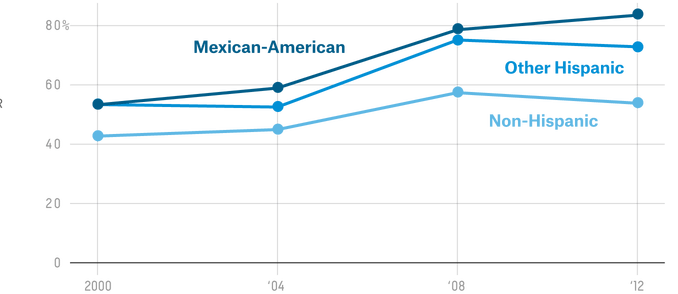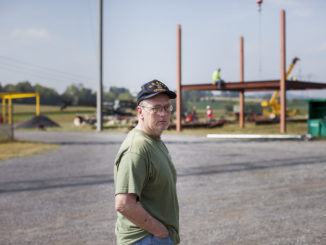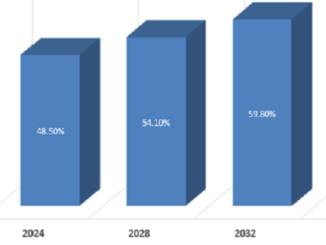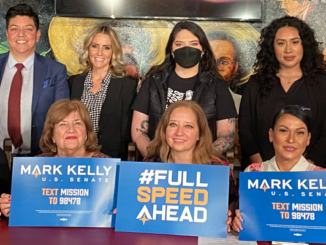
by Farai Chideya
In an office suite not far from the airport, Irma Maldonado, 18, expertly role-played what she’d be doing on the city’s streets in half an hour: knocking on the doors of residents and exhorting them to vote. But not everything was a game. Before a group of young canvassers headed out for the day, a team leader at the community organizing group LUCHA mentioned that someone had earlier pulled a gun on two members of the team.
“Everything was OK,” the organizer said, but Maldonado and the 15 or so other teens and 20-somethings were given safety whistles before hitting the streets.
Maldonado has a personal stake in America’s immigration debate, which has been making headlines throughout the election, particularly because of Donald Trump’s description of Mexicans as rapists and his desire to have Mexico pay for a border wall.

“Before going into high school — it was the summer of 2012 — my mother decided to self-deport to Mexico” with her two youngest children, Maldonado said. Maldonado, who was born and grew up in New Mexico, had a hard time adjusting to life in Nayarit, Mexico, a small state on the Pacific coast north of Puerto Vallarta, especially given that she hadn’t known her family’s status. “I think it was right when we had to move when I actually realized that my mom wasn’t actually legal here in the United States, when I was 14 years old,” she said. Her father, who has a green card, continues to work in New Mexico; Maldonado now is a first-year nursing student and lives with her 23-year-old sister in Arizona. Her mother and brother remain in Mexico.
Mexican-Americans such as Maldonado may help determine the political future of Arizona — and the nation — in a landmark election year. In an August survey, respondents were asked if Trump and Clinton made their respective parties more welcoming or more hostile to Latinos. Nine percent of Mexican-Americans said Trump made the GOP more welcoming; 74 percent said he made it more hostile. By contrast, 59 percent said Clinton made the Democratic party more welcoming; 9 percent said more hostile. An October poll by Latino Decisions found that 17 percent of Latino voters nationwide said they support Trump or are leaning toward him; 70 percent supported Clinton.

In Arizona, a state long dominated by Republicans, Clinton and Trump are in a virtual tie, according to a Monmouth University Poll released last week. Latino voters, who make up a fifth of the state’s electorate, are supporting Clinton over Trump by 35 percentage points. And critical to the electoral vote, only 9 percent of Latino voters who support Trump are in battleground states. Overall, 13 percent of the eligible voters in battleground states are Latino.
Arizona “was this strong, powerful red,” said Pita Juarez, 29, the communications director for the One Arizona coalition, an umbrella group of 14 advocacy groups, including LUCHA, that is working to boost Latino voter turnout. “Just today, we saw on FiveThirtyEight … it’s a light blue. And that’s something that I thought, really, I would never see.” (Arizona has gone back and forth between light blue and light red in FiveThirtyEight’s forecast over the last few weeks. Currently, Trump has a slight edge in the state’s forecast.)
Gabriel Sanchez, a professor of political science at the University of New Mexico and a principal at the opinion research firm Latino Decisions, said Latinos are more enthusiastic about voting this year than in 2012, having been mobilized by Trump’s comments targeting Mexicans. He added that the Republican Party will have a hard time winning over Mexican-Americans in subsequent elections unless it supports comprehensive immigration reform.
Like black millennials, younger Latinos show much weaker enthusiasm for Clinton than their elders. According to the October GenForward survey, conducted over the first half of the month, 44 percent of Latinos ages 18-30 plan to vote for Clinton and 8 percent will vote for Trump, with 10 percent going to third-party candidates. Nineteen percent said they didn’t plan to vote, and 12 percent were undecided.1
Mark Hugo Lopez, director of Hispanic research at the Pew Research Center, said that much of the growth in the Latino electorate in coming years will be from U.S.-born Latinos entering adulthood. Like other cohorts of younger voters they tend to be more supportive of bigger government, in contrast to older Mexican-Americans, who are more likely to hold conservative views. “Mexican-Americans are more likely to be Catholic than other groups of Latinos,” he said. “They are also more likely to be third or higher generation than other U.S. Latino groups and as a result to have served in the military. Both of these characteristics correlate with conservative views on many issues.” He noted that George W. Bush won at least 40 percent of the Latino vote in 2004.
Mexican-Americans constitute 63 percent of the 57 million U.S. Latinos. Some Mexican-Americans can trace their heritage in New Mexico and other regions later acquired as U.S. territory back to the 1600s and earlier, while others are recent immigrants. Of the 35.8 million people of Mexican descent in the U.S., 68 percent are native born, and more than a quarter of those born in Mexico have become U.S. citizens. Separate estimates from the Pew Research Center indicate there were 5.8 million unauthorized Mexican citizens in America in 2014, 52 percent of the total unauthorized immigrant population. The Census Bureau considers Latinos in the U.S. to be an ethnicity, not a race, and thus Latino respondents can also mark any or multiple races; about a quarter identify as Afro-Latino. But only 1 percent of the population of Mexico is Afro-Latino, according to a recent census in that nation, the first to count the category.2
Nationwide, 11 percent of eligible voters are Latino, but in Arizona, 22 percent of eligible voters are. The state is currently going through a fierce local battle involving Sheriff Joe Arpaio that is arguably fanning the fires of Latino voter turnout as much as the national election.
Arpaio is an outsize figure who has served as Maricopa County sheriff for 23 years; run jails where the men must wear pink underwear and striped uniforms; and organized citizen border patrols with actor Steven Seagal. Arpaio also has a December court date on a contempt charge for violating a 2011 injunction against stopping people on the suspicion that they were not in the country legally. (He alleges the prosecution is politically motivated because of his support for Trump.) And just one week from now, Arpaio faces perhaps an even bigger challenge: a re-election bid with polls showing him trailing his challenger by 15 points.
LUCHA’s canvassers are campaigning against Arpaio, and there are indications that his presence on the ballot is motivating new voters. In Maricopa County, Democratic voter rolls rose by 13 percent since 2012, according to figures released in August, compared to a 7.6 percent increase for Republicans. And many Latinos register as independents but lean Democratic.
Some of the young activists who are canvassing for LUCHA are undocumented, according to One Arizona’s Juarez, and in other areas around the country with significant Latino populations, immigrants who are not yet on a path to citizenship are playing a role in the political process. One of them is Yessica Vasquez Moctezuma, 25, a bank teller, who will graduate this fall with a bachelor’s degree in political science from the University of Texas at San Antonio. She has been in the United States for 19 years, which means she was undocumented until 2012, at which point an executive order qualified her for temporary but renewable DACA (Deferred Action for Childhood Arrivals) status.
Vasquez Moctezuma is frank in her assessment of her family’s legal status, since her parents are not eligible for DACA and continue to work without documentation.
“We are breaking some laws just by being here illegally, but we bind to the laws here,” she said. “We pay our taxes every year, like any other citizen would.” She worries that her parents, who have paid into the Social Security system — which receives an estimated $12 billion a year from undocumented immigrants and their employers — will never receive benefits and will never be able to truly retire. Still, she said, “This is why I studied political science, because I love the government here. I feel like in so many ways it’s so great.”
For her part, Irma Maldonado said she is excited about voting in her first presidential election. After remaining undecided until early October, she decided to vote for Clinton. But she added, “Honestly, this election, a lot of people are not that pumped to vote. It’s really kind of sad.” The number of Mexican-American and Latino voters who show up on Nov. 8 could determine the outcome in her state, and possibly in the nation.
Farai Chideya is a former senior writer for FiveThirtyEight.
This is the final installment of the FiveThirtyEight series, The Voters.



